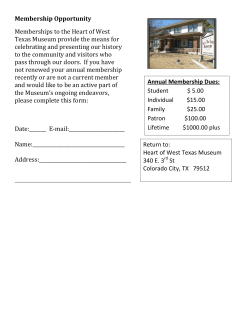
Press Release - Hood Museum of Art
Water Ways: Tension and Flow News Release | Contact: Nils Nadeau, Head of Publishing and Communications | (603) 646-2095 | nils.a.nadeau@dartmouth.edu Hood Exhibition Links Art and the Environment Water is ubiquitous in our lives. We use it for drinking, cooking, cleaning, and recreation. It affects where we choose to live and is integral to many people’s work. Water Ways: Tension and Flow, opening at the Hood Museum of Art, Dartmouth College, on April 4, 2015, explores water’s impact on human life and humanity’s impact on water. Drawn primarily from the Hood’s permanent collection, the exhibition is comprised of over two dozen works from around the world. Most are twentieth- and twenty-first-century photographs demonstrating a range of approaches to landscape and portraiture. David Goldes’s Water Balance (1994) shows a small dish of water filled to the brim. Pins ring the edge, like numbers on a clock, balancing on the top of the water and demonstrating the concept of surface tension. This interest in close scientific observation is also evident in Harold Edgerton’s Water from a Faucet (1932). Edgerton used a strobe light to freeze a stream of water in a moment of time—allowing us to view an everyday occurrence in a new way. This perspectival shift also occurs in Australian photographer Peter Eve’s dramatic aerial view of a bend in the River Wandjina. The intersection of water and environmental issues is an underlying theme throughout the show, as seen in a photograph by James Balog of a melting glacier, as well as one by Edward Burtynsky of the oil spill in the Gulf of Mexico in 2011 (above). Ian Teh’s work explores pollution in China with a photograph of the Kuye River, while Emmet Gowin’s explores nuclear power in the United States with a photograph of the Columbia River and Hanford Nuclear Reservation in Washington State. This exhibition, which also includes Roman and Egyptian depictions of the Nile from the first century BCE and the sixth century CE, is organized in conjunction with the Nile Project, in residence at the Hopkins Center from April 13 through 18. This group of musicians, educators, and activists collaboratively addresses environmental and cultural issues in the Nile basin. The Nile Project will perform on Friday night, April 17, in the Hopkins Center (tickets available through the Hop Box Office). Related programming at the Hood Museum of Art also includes a screening of the feature documentary Watermark, from multiple-award-winning filmmakers Jennifer Baichwal and Nick de Pencier and photographer Edward Burtynsky, on May 20. Water Ways was organized by the Hood Museum of Art and made possible by the Harrington Gallery Fund. 1 Water Ways: Tension and Flow News Release | Contact: Nils Nadeau, Head of Publishing and Communications | (603) 646-2095 | nils.a.nadeau@dartmouth.edu About the Hood Museum of Art The mission of the Hood Museum of Art, as a teaching museum, is to create an ideal learning environment that fosters transformative encounters with works of art. This dynamic educational and cultural facility houses one of the oldest and largest college collections in the country, with more than 70,000 objects acquired since 1772. Among its most important works are six Assyrian stone reliefs that date from around 900 BCE. The collection also presents art from other ancient cultures, the Americas, Europe, Africa, Papua New Guinea, and many more regions of the world. The Hood seeks to inspire and educate through direct engagement with original works of art and offers access to the rich diversity of its collections through ongoing highlights displays, special exhibitions, an online collections database, and a wide array of programs and events. About Dartmouth Founded in 1769, Dartmouth is a member of the Ivy League and consistently ranks among the world’s greatest colleges and universities. Dartmouth has forged a singular identity for combining its deep commitment to outstanding undergraduate liberal arts and graduate and professional education with distinguished research and scholarship in the arts and sciences and its three leading professional schools—the Geisel School of Medicine, Thayer School of Engineering, and the Tuck School of Business. Media Contacts Hood Museum of Art Nils Nadeau: (603) 646-2095 • nils.a.nadeau@dartmouth.edu Dartmouth College Office of Public Affairs (603) 646-3661 • office.of.public.affairs@dartmouth.edu Image caption: Edward Burtynsky, Oil Spill #1, Rem Forza, Gulf of Mexico, May 11, 2011, digital chromogenic color photograph. Hood Museum of Art, Dartmouth College: Gift of Nancy and Thomas F. O’Neil III, Class of 1979; 2014.66.11. © Edward Burtynsky, courtesy Nicholas Metivier Gallery, Toronto / Howard Greenberg Gallery and Bryce Wolkowitz Gallery, New York Edward ##### 2
© Copyright 2025











